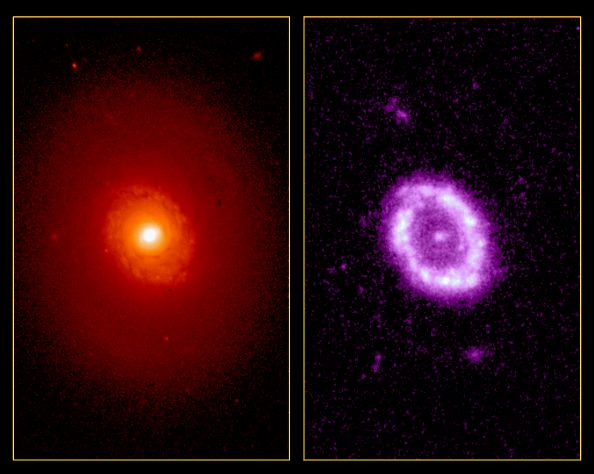
|
Explanation: Today's galaxy, M94 (NGC 4736), lies 15 million light-years away in the constellation Canes Venatici. In the red light image (left), its very bright nucleus and tightly wound spiral arms seem to slowly fade into a faint outer disk. But when viewed in wavelengths shorter than blue light - ultraviolet (UV) light - its appearance dramatically changes. While the red light image highlights the older, cooler stars of M94, the UV picture (right), from the shuttle-borne Ultraviolet Imaging Telescope, is dominated by clusters of massive, hot stars a mere 10 million years young. These UV bright young star clusters are mostly arranged in a stunning ring nearly 7,000 light-years wide around the galactic nucleus. What controls this star forming activity? Exploring wavelengths beyond the blue, astronomers now have evidence that star forming activity in galaxies like M94 can be orchestrated by the symmetric structure of the galaxies themselves instead of the titanic galaxy-galaxy collisions suspected in yesterday's case of the Cartwheel galaxy.
|
January February March April May June July August September October November December |
| ||||||||||||||||||||||||||||||||||||||||||||||||
NASA Web Site Statements, Warnings, and Disclaimers
NASA Official: Jay Norris. Specific rights apply.
A service of: LHEA at NASA / GSFC
& Michigan Tech. U.
Based on Astronomy Picture
Of the Day
Publications with keywords: NGC 4736 - ultraviolet - star formation - M 94
Publications with words: NGC 4736 - ultraviolet - star formation - M 94
See also:
- APOD: 2025 December 9 Á The Heart of the Soul Nebula
- APOD: 2025 July 10 Á Lynds Dark Nebula 1251
- APOD: 2025 June 23 Á W5: Pillars of Star Formation
- APOD: 2025 April 28 Á Gum 37 and the Southern Tadpoles
- APOD: 2025 March 26 Á Star Formation in the Pacman Nebula
- Starburst Galaxy Messier 94
- APOD: 2024 October 22 Á M16: Pillars of Star Creation
